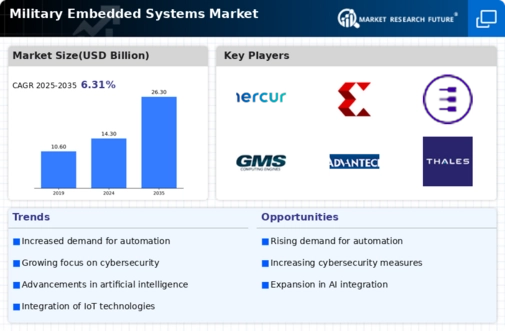Leading market players are investing largely in research and development to expand their product lines, which will help the military-embedded systems market grow even more. Market participants are also undertaking different strategic activities to expand their global footprint, with important market developments including new product launches, contractual agreements, mergers and acquisitions, higher investments, and collaboration with other organizations. To expand and survive in a more competitive and rising market climate, the military embedded systems industry must offer cost-effective items.
Manufacturing locally to minimize operational costs is one of the key business tactics manufacturers use in the global military embedded systems industry to benefit clients and increase the market sector. In recent years, the military embedded systems industry has offered some of the most significant medical advantages. Major players in the military embedded systems market, including SMART Embedded Computing (US), EUROTECH (Italy), KONTRON AG (Germany), Curtiss-Wright Corporation (US), and others, are attempting to increase market demand by investing in research and development operations.
Mouser Electronics is a global leader in the authorized distributor of semiconductors and electrical components from over 1,200 manufacturers, with local sales and service locations worldwide. We specialize in bringing new items and technology to design engineers and purchasers as quickly as possible.
Recent News :
In April 2024, Tekever, a company specializing in uncrewed aerial systems (UAS), introduced its new modular ARX platform in Lisbon, Portugal. The ARX, Tekever's inaugural UAS with swarm capabilities, offers users the flexibility to select from a range of sensors, including EO/IR, LIDAR, SAR, and SIGINT/COMINT/ELINT. The ARX is equipped with advanced onboard artificial intelligence/machine learning (AI/ML) capabilities, SATCOM and mesh connection, and the capability to function in GNSS-denied conditions both at sea and on land. Tekever also provides the "ARX Digital Twin" alongside the ARX launch.
This model serves as a digital representation of the system and may be used for simulation, integration, testing, monitoring, and maintenance. The ARX is scheduled to be released in 2025. In February 2024, Vecow Co., Ltd., a group of international specialists in embedded technology, introduced their new Fanless High-Endurance System designed for workstation use. The Vecow HEC-1000 is specifically engineered to be deployed in demanding environments, offering robust computing power based on the 13th Generation Intel® Core™ i9/i7/i5/i3 processor.
It is equipped with dependable input/output interfaces, making it ideal for outdoor applications such as Advanced Driver Assistance Systems (ADAS), Autonomous Mobile Robots (AMR), Robotic Control, and rugged Edge Artificial Intelligence (AI) deployments. The Vecow HEC-1000 is equipped with a maximum of 24-core 13th generation Intel® Core™ i9/i7/i5/i3 Processor (Raptor Lake-S). The system operates on the Intel® R680E PCH with a 35W TDP CPU, providing high-level computational power specifically designed for Edge AI applications. In addition, the system incorporates three 2.5GigE LAN connections and supports TSN technology, which enables it to effectively manage demanding workloads.
The HEC-1000 is equipped with MIL-DLT-38999 connectors that offer IP66-rated protection, allowing it to function in extreme temperatures and cold environments while remaining resistant to moisture. This military-grade design ensures high reliability, making it suitable for critical applications such as outdoor AMR, defense, military, and robotic control. For instance,In February 2020 Mouser Electronics, Inc., the New Product Introduction (NPI) leader that enables innovation, announced a global distribution agreement with Kontron, a leading global provider of Internet of Things (IoT)/Embedded Computing Technology (ECT) and a Premier Member of the Intel Internet of Things Solutions Alliance.
Curtiss-Wright Corporation is a manufacturer and service provider based in Davidson, North Carolina, with plants and operations in and beyond the United States. Curtiss-Defense Wright's Electronics business offers critical aerospace, ground, and naval defense systems and support to national and international military forces. In September 2022, Curtiss-Defense Wright's Solutions division stated that it had been chosen once again by a top defense system integrator to supply its embedded Security IP module technology. Curtiss-Wright will offer its XMC-528 Mezzanine Card under the contract to add cutting-edge security protection to an existing system within a DoD end-state application.


















Leave a Comment